Preferred temperature (Ref.
115969): 11.7 - 27.7, mean 17.8 (based on 912 cells).
Índice de diversidade filogenética (Ref.
82804): PD
50 = 0.7500 [Uniqueness, from 0.5 = low to 2.0 = high].
Bayesian length-weight: a=0.01000 (0.00911 - 0.01097), b=3.01 (2.98 - 3.04), in cm Total Length, based on LWR estimates for this species (Ref.
93245).
Nível Trófico (Ref.
69278): 2.8 ±0.0 se; based on diet studies.
Resiliência (Ref.
120179): médio(a), tempo mínimo de duplicação da população 1,4 - 4,4 anos (K=0.16-0.4; tm=1-2; Fec=395,000).
Prior r = 0.59, 95% CL = 0.39 - 0.89, Based on 13 stock assessments.
Fishing Vulnerability (Ref.
59153): Moderate to high vulnerability (51 of 100).
Climate Vulnerability (Ref.
125649): Low vulnerability (6 of 100).
